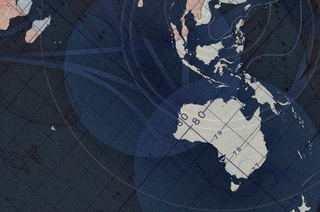The headlines
Few uncertainties about President Trump’s second term of office concerned US allies and partners more than the administration’s policy toward China.
On one hand, the first Trump administration introduced strategic competition with China, implemented significant tariffs on trade with China and bolstered defence ties with key US allies like Australia and Japan. On the other hand, the first Trump administration often seemed more concerned with the US trade balance with China than more structural issues that other presidents made central to their China policy. While Donald Trump focused on the negotiation and implementation of the 2020 ‘Phase One’ trade deal with China, less administration attention was paid to China’s takeover of Hong Kong, internment camps in Xinjiang, extensive cyber attacks, militarisation of the South China Sea and omnipresent threats to Taiwan.

After taking more than a year to begin implementing tariffs in his first administration, President Trump targeted the bilateral trade relationship with China far quicker and more aggressively than he did in his first term of office. Less than two months after taking office a second time, President Trump enacted a series of tariffs on a number of countries but none more so than China, which faced 20% tariffs. Beijing enacted retaliatory tariffs, among other measures, though making sure to do so only after the United States’ first moves.
Yet while most countries sought to negotiate or not retaliate against the Trump administration’s 2 April “Liberation Day” tariffs, China stood apart for its retaliatory tariffs. As a result, most of the administration’s tariffs were paused or significantly relaxed less thana week after they were announced but one nation was excluded from that pause: China, which actually faced increased US tariff levels even further. This, in turn, led to a series of escalations that culminated in the United States enacting a 145% tariff on Chinese goods and retaliatory 125% Chinese tariffs on US goods before agreeing to a 90-day pause ending in early July 2025.
Outside of his tariffs, President Trump has accused Taiwan of stealing the US semiconductor industry while maintaining more ambiguity about his Taiwan policy than President Biden did. At the same time, the administration’s dramatic cuts in US humanitarian aid and government spending — impacting not only USAID but also impactful NGOs, broadcasting programs and the Defense Department’s Office of Net Assessments — resulted in the hobbling or outright de-funding of strategic tools that prior administrations deemed to be strategic assets.
What is happening behind the headlines?
President Trump has once again injected significant uncertainty into global markets and alliance relationships around the world. However, like the Biden administration — the administration’s security policy has also simultaneously proceeded along a path in Asia centred around allies and partners. That path has included Secretary of State Rubio’s attending of the Quad foreign ministerial mere hours after his January swearing in ceremony, President Trump’s bilateral meeting with Japanese Prime Minister Ishiba in February, and Secretary of Defense Hegseth’s trip to the Philippines and Japan in March. In each of these engagements, the Trump administration emphasised a vision consistent with the first Trump administration’s 2017 Free and Open Indo-Pacific Strategy.
The second Trump administration is again prioritising deterrence against China through deepened security relationships with allies and partners in the region while also prioritising bilateral economic “deals” with friends and adversaries alike – most notably China.
The Trump administration thus far remains remarkably consistent from its first term in its security and economic outlooks on Asia. As much as the first Trump administration left office having shifted the military balance around China through resuscitating the Quad and deepening defence ties with US allies in Asia, the same administration also abandoned an alliance-centric multilateral economic architecture in Asia and instead prioritised tariffs and bilateral agreements.
The second Trump administration is again prioritising deterrence against China through deepened security relationships with allies and partners in the region while also prioritising bilateral economic “deals” with friends and adversaries alike – most notably China. In other words, the Trump administration’s China policy is, from a security lens, more consistently ally-centric than not but from an economic lens – and potentially from a technological lens too –consistently not ally-centric. Allies and partners remain particularly concerned for the possibility of another bilateral US-China trade agreement which may come at the expense of their own economic wellbeing.
While it is likely that some spending cuts to USAID, Voice of American, Radio Free Asia and other impactful organisations will eventually be reversed by US courts or re-funded by a future Congress, there is no denying that the dismantlement or altogether dissolution of them creates a vacuum in parts of the region, ranging from Southeast Asia to the Pacific Islands, in the short term that Beijing is keen to fill.
These actions ultimately result in a muddied US policy toward China. This administration’s strategic ambiguity toward Asia cuts both ways: determining what exactly the Trump administration wants remains challenging for both China and US allies and partners alike. With that said, the Biden administration had its own challenges defining its desired ‘end state’ in its relationship with China.
Key debates happening the issue
As opposed to Russia and European matters, there remains little debate about the importance of the challenge of China in the Trump administration, Congress or public opinion. The famously bipartisan consensus on China largely began during the first Trump administration, persisted through the Biden administration and continues unabated in the second Trump administration. With that said, there remains fierce debates on how and where to challenge China.
A remarkably consistent 77-83% of Americans have held an unfavourable view of China since 2020. Yet while one late 2024 poll found a majority of Americans want to limit the growth of China’s power and say that US trade with China weakens US national security, a majority of Americans (52%) also say that the US tariffs on China will be bad for the United States and that their top goal for US-China relations (69%) was avoiding military conflict with China.
Like all administration, the Trump administration itself has diverse views of China. While “China hawks” like Marco Rubio and Pete Hegseth favour strategic competition that weakens Beijing and prepares for contingencies, business types like Elon Musk broadly seek to stabilise relations. The administration’s actions reflects these tensions – they administration has simultaneously sought to remove Chinese interests in the Panama Canal while extending TikTok’s ability to operate in the United States.
Much like in the first Trump administration, Congress remains focused on areas of strategic competition that are not often prioritised by President Trump, including increasing military spending and criticising China’s human rights record.
Presidents Trump and Xi are both keen to highlight their respective victimisation by foreign nations as well as their strength and abilities to outlast each other.
The fiercest debate concerns China’s power, its resilience to the Trump administration’s tariffs and whether the Trump administration’s tariff strategy will embolden or weaken China. While the United States recently saw its first quarter economic contraction since 2022 and bond market gyrations unprecedented in the modern era, China is also experiencing its lowest levels of economic growth in decades, with reports of record levels of unemployment and social unrest.
Presidents Trump and Xi are both keen to highlight their respective victimisation by foreign nations as well as their strength and abilities to outlast each other. The 90 day pause in triple digit tariff rates plus the numerous exemptions to the trade war — Beijing has exempted eight categories of US-made semiconductors from tariffs while the Trump administration has exempted iPhones and other electronics from tariffs — make clear that presidents Xi and Trump are more dependent on each other than they like or would readily admit.
The implications
Unprecedented Chinese military drills across the Indo-Pacific — including in the Tasman Sea between Australia and New Zealand — have heightened anxiety about a Taiwan contingency. US allies and partners will need to engage in extensive preparation for the security and economic implications of this scenario. Russia’s invasion of Ukraine made clear that the security and economic impact of even well-known hypothetical contingencies can have unforeseen security and economic implications.
Ultimately middle powers like Australia and Japan will once again be forced to assume a greater burden of responsibility in providing a ballast of stability in the economic arenas while simultaneously consolidating progress in security arenas.
Outside of a Taiwan contingency, should presidents Trump and Xi ultimately come to revisit the previous ‘Phase One’ trade deal or create a new bilateral agreement altogether, allies and partners should prepare for even greater trade diversions than the first Trump administration amidst persistent economic uncertainty.
Ultimately middle powers like Australia and Japan will once again be forced to assume a greater burden of responsibility in providing a ballast of stability in the economic arenas while simultaneously consolidating progress in security arenas.
What to watch moving ahead
- Economic impact of tariffs: China and the United States are both suffering the consequences of unprecedented tariffs. The United States’ open and democratic system allows for more transparency on the economic and political impact though dissatisfaction among Chinese citizens is increasingly visible too.
- A presidential summit: A bilateral meeting between presidents Trump and Xi Jinping will be the most consequential event that the two presidents will prioritise. Earlier in the year, media reported a June summit was likely but thus far no meetings have been confirmed. Such a meeting would may for a broader economic agreement.
- Persistent and consistent US security ties around China: Regardless of the meeting, the Trump administration can be expected to continue to seek to shape security dynamics around China’s deepened engagements with US allies and partners in the region, including numerous bilateral meetings as well as a Quad summit in India set to occur in 2025.
What should allies like Australia do about it?
Australia should be unafraid to increase engagement in areas where the United States is less present. While this most notably includes economic engagement in the Indo-Pacific through groupings like the Comprehensive and Progressive Trans-Pacific Partnership and Regional Comprehensive Economic Partnership, it is by no means limited to that. Ranging from development and humanitarian assistance to international standards organisations, it is in Australia’s interests to continue to increase its burden sharing the responsibility of maintaining a rules-based order.
Unpacking trump 2.0









